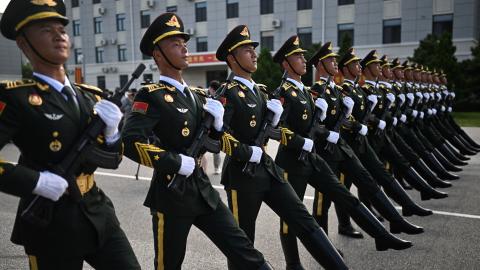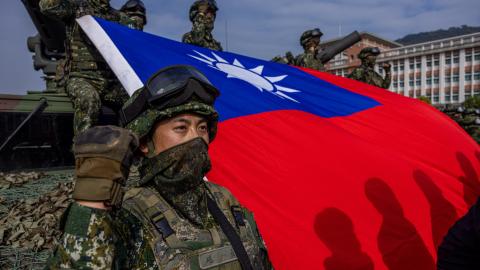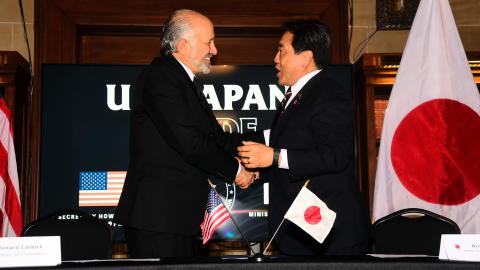The year 2011 will undoubtedly be remembered as pivotal in the evolution of political thought and practice in the Arabic-speaking world. The revolutions, uprisings, and protests that have toppled regimes, and which are forcing many of the region's remaining autocrats to take defensive measures, have also transformed Arab political culture and the set of political choices previously available to ordinary Arabs.
Before the “Arab Spring,” the prevailing assessment of political thought in the Arabic-speaking world identified Islamism as the main engine of political formulation and dissent. Secular and democratic ideas seemed weak by comparison, and the regimes themselves were suffering from systemic legitimacy crises that were due partly to the decline of nationalist ideologies. To the extent there was a contest of ideas, it was between competing currents of Islamism. Indeed, a multitude of Islamist streams appeared to dominate the political, intellectual, and cultural spheres. As a consequence of this, ordinary people were largely restricted to three courses of political action. First, they could accept autocratic rule and recognize its ability to bestow rewards and inflict punishments, either through passive acquiescence or direct complicity. Second, they could dissent by embracing one of the various currents of Islamism, which might favor a reformist or “accomodationist” approach to Islamic revival and political change, or it might lead to a more radical and rejectionist approach to the existing order. Third, people could succumb to the escapism offered by a popular culture constructed around unattainable notions of self-indulgence and consumerism.
In this pre-2011 configuration of Arab politics, democratic, liberal, progressive and secular ideas had seemingly no tangible influence, and they were implicitly rejected as irrelevant to Arab political realities by autocratic governments and the Islamist opposition alike. At the same time, both autocrats and Islamists acknowledged the existence and appeal of secular democratic principles insofar as this served their own agendas. Autocrats, for example, sought to fend off criticism from their Western partners over the restrictive political atmospheres they imposed by periodically making concessions to democratic demands-though they were always to keep the proponents of democracy marginal and ineffective. Islamists, too, acknowledged the existence of secular and liberal ideas in Arab societies-but only insofar as this offered proof of what the theocrats alleged was a Western onslaught of Islamic identity and values.
Thus far, however, the events of 2011 have demonstrated that both autocrats and theocrats had underestimated the appeal of secular and democratic ideas. Now, with the autocrats either out of power or on the defensive, the Islamists have been forced to respond openly to secular and democratic ideas and popular aspirations. This reality has prompted a reassessment of Islamist tactics and strategy.
Islamism in its multiple expressions remains a very potent force in Arab political culture today. Thanks to their substantial finance networks and organizational capacity, Islamists may even emerge as the immediate winners of the Arab Spring. However, Islamism no longer enjoys the virtually uncontested ideological supremacy that it once had on the Arab scene. Instead, the center of gravity of the political debate across the region has moved decisively away from the contest between autocrats and competing theocrats, and toward what only recently seemed to be the fringe. Now, the locus of the competition of ideas within Arab societies is between competing strains of Islamism and the positive propositions of secular democracy.
Importantly, this shift has occurred not because of intellectuals, but because of the success of activists in the field at mobilizing large crowds on the basis of concrete issues that resonate widely (in particular the injustices inflicted by the regimes, and the poor performances of some Arab economies). The shift was not produced nor has it been accompanied by a new, coherent secular democratic agenda or an intellectual deconstruction of the impasses of autocracy and theocracy. Nonetheless, the activists' success has created a new configuration in Arab political debate. The popular demands and slogans of the Arab Spring, which spread virally from one locale to the next, were simple: "hurriyah, izzah, karamah"-freedom, empowerment, dignity. While these demands were and remain poorly articulated, they were remarkable for the fact that they eschewed the ideas, concepts and values of Islamism.
The fact that the Arab Spring activists poured into the streets for something other than an “Islamic State” came as not only a surprise but a challenge to the Islamists-and especially to those who presumed to know and represent the aspirations of ordinary people. This has since become a central problem for Arab Islamist thought, as well as the subject of a new intra-Islamist debate. In fact, the Arab Spring has exposed a heretofore largely unsuspected weakness in Islamism. Unlike the activists of 2011, Islamists have not been as successful in recent years at mobilizing the Arab street in accordance with their ideological agenda. This is in part because Islamism in all its expressions is necessarily an elitist ideology, as it calls for a fundamental departure from aspects of Islam as it is in actuality, and also because it seeks to realize this departure through a program of “Islamization” led by a pious Islamist vanguard. As a reflection of this elitism, Islamist discourse is built on two patronizing conceits: one, that Muslim society and individuals are helplessly vulnerable to malevolent, non-Islamic influences and, two, that Muslims must be awoken from their “malaise” and “re-Islamized.” In virtually all Islamist treatises, Muslim peoples are effectively immature and child-like, and can easily be swayed by Western plots and duped by crude Masonic-Zionist machinations.
Historically, an important source of disagreement among Islamists has been how to engage with the allegedly deficient people. Elements of the Muslim Brotherhood, for example, have advocated a gradualist and “accomodationist” approach that tolerates a degree of non-Islamic ideas and practices in the interests of creating and maintaining a popular base for the movement. Various Salafist movements, meanwhile, have been far more ideologically rigid. As such, they have shown far less willingness to compromise with un-Islamic ideas and practices, and they have bluntly rejected any idea or course of action that is not properly rooted in Islam.
In this respect, Salafism generally may be considered more “elitist” than the reformist Islamism of the Brotherhood. This helps to account for some of the prestige and importance that has been associated with Salafism within the context of the larger Islamist universe. While the Salafist movement constitutes only a small minority within the Sunni branch of Islam, the disproportionate engagement with Salafist ideals by Islamists of all currents has helped to reinforce Salafism's own frequent claims to represent the “purest” and most “authentic” expression of Islamism. The Salafist movement, which is internally quite diverse, has in fact displayed more dynamism and ideological clarity than other streams of Islamism. In part because of Salafism's perceived religious purity relative to its Islamist rivals, and also because of the enormous oil funds available to the Salafist movement's worldwide outreach, Salafist ideology enjoyed an enormous influence on Arab political discourse before the Arab Spring.
Yet the swift falls of the regimes in Tunisia and Egypt and the continuing uprisings elsewhere have forced Islamists of all persuasions to alter their rhetoric and approach to the alleged immaturity and malaise of the people. Many Salafist currents have chosen to welcome and endorse the revolutions, while toning down their previously patronizing stance toward the people. Yet in the context of the Arab Spring, Salafism as a whole risks becoming irrelevant due to its ideological inflexibility and elitism. The Muslim Brotherhood, meanwhile, has sought to capitalize on the events by stressing the value and relevance of their gradualist approach to Islamization in the new Arab political context. Brotherhood activists now claim to fully embrace the popular slogans of the “Arab Spring,” and they contrast their position with the alienating elitism and rigidity of their Salafist rivals.
The popular uprisings of the Arab Spring have therefore put Islamist ideology as a whole, and Salafism in particular, to a test. Not only does Salafism face becoming increasingly irrelevant, but it also risks losing out to those Islamist rivals who may be better suited to adapt to the new configuration of Arab politics. As Salafist scholars and activists struggle to cope with the new political reality, it has already altered the internal constitution and ideology of their movement in dramatic ways.
The Emergence of Salafism
The term “Salafism” (al-salafiyyah) is a neologism that refers to a dynamic set of frequently divergent ideological currents that share common dogmatic foundations. If Islamism may be broadly understood as the ideological proposition that a radical understanding of Islam is relevant to or is to be assigned primacy in politics, then Salafism is eminently Islamist. However, contrary to Islamist movements like the Muslim Brotherhood that may tolerate or even seek an accommodation between an authentic “Islamic politics” and other forms of government, Salafism stipulates that political legitimacy resides exclusively in Islam as (Salafists believe) it was originally revealed. While Salafists broadly agree on this principle, they frequently disagree over the legitimacy and importance of political action in their overall effort to construct an Islamic State.
The Salafist movement began to cohere in its present form around a common set of precepts only in the past few decades. The promoters of Salafist ideology claim to represent the essence of Islam, as it was originally practiced by the Prophet Muhammad, his companions, and the early generations of Muslims. Referring to these early Muslims as al-Salaf al-Salih, or “the righteous predecessors,” has been an accepted practice in Islamic scholasticism and jurisprudence for centuries. The use of derivatives from this designation to delineate a distinct set of political notions, however, is one product of the modern reform movement of the nineteenth century. The main intellectual architects of that movement, the Egyptian Azhari cleric Muhammad Abduh and his mentor Jamal al-Din al-Afghani, sought to demonstrate the compatibility of Islam with modernity. To accomplish this, they proposed a return to the original principles of the al-Salaf al-Salih, or to a “purified” Islam that was free of historical accretions and that, in their view, supported their progressive and modernizing vision. Their efforts have thus been characterized as salafi-islahi, or “reformist-purist.”
To implement their project, Abduh and his disciples set out to identify and partner with a number of movements in the Islamic world that shared their agenda of religious reform and purity. However, the main criterion that they began with-the return to the pristine purity of the faith-allowed widely different interpretations, and thus proved too imprecise and fluid. This ultimately allowed for the inclusion of new ideas into the emerging salafi-islahi project that may have been consistent with the project's goals of religious reform and purity, but not its original modernizing vision. In the course of the early twentieth century, the emerging salafi-islahi movement thus began to intermix with the literalist teachings of Muhammad ibn ‘Abd al-Wahhab of Arabia in the late eighteenth century, as well as the contemporary Sufi militant Sanusiyyah movement in North Africa. The incorporation of these and other ideas led to new debates and ultimately a split and divergence within the salafi-islahi intellectual trend between competing visions of reform and purity. By the 1920s and 1930s, both Hasan al-Banna (the founder of the Muslim Brotherhood and an early advocate of regimenting Muslims in a theocratic state) and Ali Abd al-Raziq (an Azhari scholar who sought to build a secular civil state rooted in Islamic doctrine) could legitimately claim to be the intellectual heirs to Muhammad Abduh's salafi-islahi project.
The decolonization and revolutions of the Arab world in the 1940s and 1950s produced a rapid evolution in Arab political thought, and the salafi-islahi project itself was supplanted by new political ideologies that sought legitimacy outside of an Islamic framework. Local versions of liberalism, nationalism, and socialism became the chosen ideologies of the elites that dominated Arab political discourse in the following decades. These elites accepted Islam as merely one element in the composition of the local and national identities. They also regarded religion as a declining force in society and politics.
The rise of Islamism in the latter part of the twentieth century has been due in no small part to the successive bankruptcies of these three grand political narratives and their failures to deliver on progress, “social justice,” accountable governance, as well as a long-wished-for Arab victory over Israel. Moreover, at the dawn of the fifteenth Hijri century, four events took place and combined to establish the prominence of Islamism-and Salafism especially-in Arab political culture. The first of these events, the 1979 Islamic Revolution in Iran, demonstrated the possibility of overthrowing a repressive regime backed by the West. Second, the ultimately successful 1980 anti-Soviet Jihad in Afghanistan laid the operational infrastructure for a politically more potent Islamist and jihadist internationale that enjoyed great popular prestige. Third, the uprising of the Syrian branch of the Muslim Brotherhood against the al-Assad regime in Damascus, which ended with the 1982 Hama massacre, ultimately cemented Islamism's place as the primary anti-order ideology in the Arab world.
The spectacular fourth event-the takeover of the Meccan Holy Shrine by millenarian Islamists in 1979-may have been promptly contained and suppressed by the Saudi regime. The event, however, electrified Islamists everywhere, while serving as a catalyst for the further polarization of Arab politics. More fundamentally, the siege of Mecca was an expression of underlying developments within the religious doctrine and practice of Saudi Arabia that are still influencing Islamism, and the Muslim world more generally, to this day.
The Kingdom of Saudi Arabia, which was created through the conquests of Abd al-Aziz al-Saud in the 1920s, is the latest incarnation of the late eighteenth century partnership forged between the al-Saud tribe of Najd and the religious dynasty of al-Shaykh, who were heirs to the puritanical teachings of Muhammad ibn Abd al-Wahhab. The dawa of the latter deemed Sufi, Shiite and other Islamic doctrines as heretical, and called for their eradication. This ambition was given teeth by the military might of the latter, whose absolute temporal authority was, in exchange, confirmed by the religious authorities. With his kingship well-secured, Abd al-Aziz began to adjust the terms of the relationship between the monarchy and the religious authorities. The king eliminated the al-Ikhwan, the religious pan-tribal militia over which the clerical establishment had considerable influence, and compensated the religious scholars by granting them new authorities over the social life within his kingdom.
Abd al-Aziz's actions ultimately established the arrangements between the political and religious authorities of the Saudi kingdom that are still in place today. Moreover, by endowing the religious scholars with stability, influence, and an income (that grew geometrically with the advent of oil revenue), King Abd al-Aziz unwittingly enabled the religious institutions of Saudi Arabia to acquire a vastly disproportionate influence over Islamic thought globally. Nowadays, international students are invited to study at religious universities in Saudi Arabia so that they may serve once they return home as vectors for the propagation of Saudi-based religious ideas. Naturally, these students and their countries of origin are not passive recipients; the reception and use of Saudi ideas is conditioned by a multitude of factors, including their relevance and utility to other countries. Moreover, Saudi Arabian society is not immune to incoming influences either. Still, the availability of ideas incubated in Saudi Arabia as an option is made possible by the extraneous factor of oil wealth.
The many currents of modern Salafist ideology are themselves products of a still unfinished intermixing of and negotiation between ideas indigenous to Saudi society and foreign ideas, especially from Egypt. The doctrinal foundation of Salafism clearly derives from the austere and militant dawa of Muhammad ibn Abd al-Wahhab (who self-consciously followed the model of the thirteenth-century scholar ibn Taymiyyah). His successors in the Saudi Kingdom reinterpreted his teachings and institutionalized them by making them the ideology of an established clerical class funded by and supportive of the monarchy. The subsequent injection of political activism and the imperative of jihad that would come to challenge and counter the political quietism and unconditional loyalty to political authority that was once prevalent among Saudi religious scholars occurred through the popularization of the opinions of scholars from Egypt (such as Muhammad Qutb), Syria (such as Muhammad Surur Zayn al-Abidin), Palestine (such as Muhammad Azzam), and elsewhere.
Salafist Doctrine
The Salafist movement in its multiple expressions is best analyzed in light of its scholastic dogma, socio-political agenda, and political ideology. The differences between Salafist currents are less pronounced at the level of the socio-political agenda (all seek a return to an “Islamic State”) and are minor to non-existing at the basic level of scholastic dogma. The distinctions between Salafist currents arise largely as a consequence of their different tactics and political ideologies, which nowadays range from requiring an unqualified obedience to the will of the ruler to mandating Islamic insurgency.
The scholastic approach of Salafism consists of the reliance on the Quran and the Sunnah of the Prophet, as understood by his companions and the righteous among his early followers. The basic tenets of this approach are strict monotheism (tawhid), total obedience to the commandments of the Prophet (taah), and a continuous effort to purify one's thoughts and actions in conformity with the sayings and deeds of the Prophet (tazkiyat al-nafs). Salafism's proponents routinely insist that they adhere to a methodological approach (manhaj) and not a school of jurisprudence (madhhab). They also insist that the Salafist method is compatible with all the established schools of jurisprudence of Sunni Islam). This self-definition of Salafism is deliberately meant to appear non-polemical, although Salafists normally supplement it with a number of qualifications that reveal their intrinsic ideological hostility toward other Islamic schools.
Customarily, the identification of the religious credentials of engaged and learned Sunni Muslims required the indication of an individual's affinity with schools and/or currents in three complementary aspects of religious life: theology (aqidah), jurispridence (madhhab fiqhi), and ritualistic practice (tariqah). Among Sunnis, the dominant theological school is the Ashari school, and the minority Maturidi and Athari schools compete for a distant second. There are four recognized schools of Sunni jurisprudence: the Maliki school, which is spread across North and Sub-Saharan Africa; the Shafii school that prevails in Egypt, much of the Levant, the Hijaz, Yemen, and parts of Asia; the Hanafi school, which dominates in parts of the Levant and Iraq, Turkey, and large swaths of Central and South Asia; and the Hanbali school, which is entrenched in the Najd area of Arabia. Far more variety historically exists (and still does, albeit decreasingly) at the ritualistic practice level, with the Qadiri, Naqshbandi, Rifai, Shadhili, Tijani, Ahmadi, and many others constituting unique families of ritualistic approaches that are steeped in the mystical wealth of Sufism. The available options in all three aspects of religious life were traditionally understood as mutually compatible (although certain combinations were more common than others). It is thus possible for a learned Muslim to be Hanafi in matters of jurisprudence, Maturidi or Ashari in theology, and Naqshbandi or Qadiri or Rifai in ritualistic practice, and so forth.
While Salafism's claim to be a methodology is simple and seemingly non-polemical, it seeks in practice the deconstruction of virtually the totality of this conventional system of Islamic identification. For example, Salafism deems ritualistic practice at best as a forbidden innovation (bidah), and rejects in toto all of its local expressions. While both the Ashari and Maturidi schools of theology seek a harmonization of reason and revelation, Salafism rejects both schools as contaminated by non-Islamic philosophical ideas, heterodox, or even heretical. The only theological school that Salafism accepts as valid is the literalist Athari school. (In actual fact, even though Salafists routinely claim the opposite, traditional Athari and modern Salafi theologies both engage in considerable kalam construction- kalam being the dynamic Islamic theological-philosophical discipline that was originally built on Hellenic and Hellenistic foundations. Ibn Taymiyyah's reconceptualization of pure monotheism as a recognition of both the Lordship (rububiyyah) and Divinity (uluhiyyah) of God-a conceptualization that is at the core of the Salafist dogma-is in language and structure a continuation of the exercise of kalam. In matters of jurisprudence, Salafists trace their methodological approach to ahl al-hadith, a scholastic teaching from early Islamic history that utilized only certain Prophetic traditions (hadith) with trustworthy chains of transmission to determine authoritative norms for social and political behavior. This scholastic approach differs greatly from the rule-based exercise of jurisprudence that was developed by the ahl al-rai school and greatly influenced the historical development of Islamic jurisprudence. As such, Salafism places itself at odds with the dominant currents of jurisprudence in three of the four major schools of jurisprudence. Only the Hanbali school of jurisprudence, which has the smallest original global footprint, is spared substantive criticism from Salafism.
In fact, Salafists commonly praise Ahmad ibn Hanbal, the founder of the Hanbali school of jurisprudence and source of the Athari school of theology, as an archetypal Salafist. Because of this, Salafists may be assumed to be merely a modern Hanbali faction. However, in line with the arguments of the fifteenth-century religious scholar and activist Ahmad ibn Taymiyyah, whom they credit with the “revival” of their methodological approach, Salafists (nominally) de-emphasize the importance of schools of jurisprudence, while insisting on the need for methodological rigor in pursuit of their identified priorities.
While the Salafist movement may resist the exclusive identification of their ideology with Hanbali jurisprudence-indeed, scholars from other traditions have also declared themselves “Salafists” in their approach-the Hanbali and, specifically, the Najdi roots of the movement are clearly evident in Salafist political ideology. While the Najd region of Arabia historically shared with the rest of the Muslim world the quasi-exclusive dominance of the dynastic model of political leadership, the socio-economic realities of this remote desert province meant that it neither developed its primitive governance institutions nor attracted to it conquest by more developed states. While in other settings the Islamic scholastic tradition routinely interacted with, influenced, and accepted evolving political systems, the Najdi dawa had no comparable exposure, and thus treated all such systems as forbidden innovation. This Najdi dawa is evident today in the dismissive way Salafists speak about and reject the political institutions with which learned and devout Muslims outside of Najd have historically interacted. It also helps to explain some of the major inconsistencies between Salafist religious and political discourse. On the one hand, Salafism presents itself as a revival of the original practice of the faith rightly understood. On the other hand, Salafist political practice shows its Najdi roots and biases through its acceptance of kingship and dynastic rule and its vocal rejections of all political institutions and ideas that seem to depart from these Najdi norms. This is despite the fact that explicit verses in the Quran reject kingship (Quran, 27:34), and also despite the fact that dynastic rule was not the practice of al-Salaf al-Salih.
Despite their claims to the contrary, Islamism in general and Salafism in particular do not offer a political counter-model for the modern political systems that they reject. The multitude of texts they invoke from the classical Islamic tradition discuss and debate the personal qualities of the just ruler, and they also offer rulers advice on virtuous conduct. Yet, these texts do not offer a basis for political theory. In fact, the central claims of Islamism-that Islam is a “total system,” and that the “political” in Islam cannot be dissociated from the “religious”-are themselves modern constructs that have gained credence and legitimacy largely because of the absence of any political theory in the Islamic scholastic traditions that might form the basis for a counter-argument. One of Islamism's greatest paradoxes resides in its unwillingness to concede the verifiable fact that it is a modern construction coupled with its inability to develop new models on the basis of Islamic principles. The latter aspect is largely due to the restrictions that Salafism, with its essentially Najdi political outlook, has managed to impose on itself and the rest of Islamism in the course of its ascendancy over the last several decades. Moreover, since its frame of reference is explicitly limited to the duration of the message of the Prophet Muhammad (twenty-two years in mid-sixth century AD), and since it strictly applies the “no innovation” rule, Salafist ideology has become a serious impediment to the Islamist exploration of new ideas and approaches. The methodological rigor promoted by the scholastic dogma of Salafism has therefore worked not only to dismantle the Islamic religious system, but it has also affected social and political life across the Islamic world.
Salafist Currents: Evolution and Gradation
Some differences among Salafists on elements of dogma have given rise to countless debates within and among different Salafist streams of thought. One issue that has caused enormous controversy is the revived notion of irja, which calls for the suspension of the denunciation of perceived transgressions against the Divine commandments of rite. This notion was espoused by an early Islamic school known as “the Murjiah,” who considered judgment over such transgressions to fall exclusively within God's jurisdiction. No pronouncement or action was therefore expected from Muslims if a fellow Muslim were to disobey ritualistic and/or belief commandments. The early opponents of the Murjiah considered their teachings to be a license for apostasy, and the school did not survive for long as an Islamic denomination. They are instead treated by the mainstream Islamic tradition as but one example among many of heterodoxy within early Islam; in their particular case, the Murjiah are accused of the “excess” of not safeguarding the religion against dissolution.
Modern Salafism espouses and amplifies the Islamic injunction to promote good actions and denounce bad deeds. To most Muslims, this injunction is generally understood as a call for individuals to proactively engage society; in modern Saudi Arabia, the injunction has also become the Salafist justification for the religious police (hayat al-amr bi-l-maruf wa-l-nahi an al-munkar). Yet the Saudi religious police, as invasive as it is, is practically incapable of enforcing Islam and policing actions that take place in the home, or in a foreign country. The Salafist pronouncements on such out-of-sight actions have oscillated between condemnation and suspension of judgment, with accusations of irja facing the proponents of the latter view. The mutual accusations of irja by one scholar against another have thus become an effective engine for enhancing the overall rigidity of Salafist doctrine and sharpening the differences between opposing Salafist currents. (The counter-accusations to irja-ghulw (exaggeration) and takfir (denunciation as apostasy)-have not acquired the negative connotation of irja, and thus have not yet commanded the vigorous self-defense and further hardening of different positions within Salafism that the accusation of irja generates.)
Such polemics notwithstanding, Salafism's multiple currents generally do share a common foundation in dogma; the differences between them, where they exist, are often due to differences in political tactics and ideology. On the eve of the Arab revolutions in 2011, one of the most important areas of gradation among the multiple Salafist currents was their respective positions on the Islamic legitimacy of political activism, which was originally a notion imported into Salafism from other Islamist movements, in particular the Muslim Brotherhood. These different positions on the religious legitimacy of political activism has been reflected in the Salafist movement's mixed responses to the Arab Spring and in the new trajectories of Salafism's diverse currents over the last year.
Scholastic Salafism, sometimes identified as al-salafiyyah al-ilmiyyah (though this designation is sharply contested), is explicitly apolitical, and avoids whenever possible any pronouncement on political issues. Scholars within this current ordinarily focus on matters of jurisprudence and theology; on the basis of the ongoing study of Prophetic traditions, they routinely enunciate on prescribed and proscribed behavior in religious and transactional practices (ibadat and muamalat), and on what distinguishes sound belief from apostasy.
The Saudi Wahhabi religious establishment is the primary locus of this particular Salafist current, although its influence is not restricted to Saudi Arabia. (Indeed, the most prominent and prolific practitioner of Scholastic Salafism in the past decades has been Muhammad Nasir al-Din al-Albani (d. 1999), a Syrian resident of Jordan, of Albanian origin.) Scholastic Salafists in Saudi Arabia regularly produce fatwas at the request of the monarchy, and thus lend religious authority to the monarchy's official positions. The wording of these fatwas, however, often only narrowly serves the purpose intended, and they often leave much open to interpretation. For this among other reasons, Scholastic Salafism is often accused of a lack of coherence.
In response to the uprising in Bahrain in February 2011, the Saudi Council of Senior Scholars (hayat kibar al-ulama), which is the most prominent institution of Scholastic Salafism, issued a fatwa forbidding demonstrations against an established ruler. However, the positions of members of the council with respect to the uprising in Syria in the subsequent months were considerably different. Two prominent council members, Salih al-Luhaydan1 and Salih al-Fawzan, vociferously attacked the Syrian regime and expressed their support for the protestors.
While the two scholars' positions toward the uprisings in Bahrain and Syria reflect those of the Saudi government, the scholars “protected” themselves against accusations of being “political” by providing a religious justification for their stand, rather than a political one. They were careful, for example, in their support for the Syrian revolution to refer to the anti-Islamic character of the Assad regime, which is based on a secularist ideology, and led by a president whose religious affiliation (Alawite) is heretical in the judgment of Salafism.
In the past, such juristic acrobatics, combined with Scholastic Salafism's economy of words on controversial issues and the political quietism of the current's main figures (such as Abd al-Aziz ibn Baz (d. 1999), Muhammad ibn Salih al-Uthaymin (d. 2001), and Abd Allah ibn Abd al-Rahman al-Jibrin (d. 2009)), has led some Islamist activists to denounce Scholastic Salafists as the “ruler's scholars” (ulama al-sultan.) At the same time, Scholastic Salafism's ambiguity on politics has also been interpreted by some of its adherents as lending tacit approval to radical action. This ambiguity has protected Scholastic Salafism as a common denominator, at a somehow equal distance from at least two other currents of Salafism. Both activist and loyalist Salafists (as described below) could thus portray themselves as consistent with the core mandated by Scholastic Salafism. This ambiguity is likely to continue to be the modus operandi of Scholastic Salafism amidst the ongoing political transformations of the Arab world.
Activist Salafism, or al-salafiyyah al-daawiyyah, borrows its focus on social engagement from activist forms of Islamism like the Muslim Brotherhood, while remaining within the doctrinal confines of Salafism. Although this current's main emphasis is on social and cultural affairs, elements of political ideology and behavior are evident in pronouncements and create potential for mobilization.
Activist Salafism emerged as a reaction to the sclerotic inability of Scholastic Salafism to confront and respond to Western ideologies in general (liberal, socialist, secularist), and in particular to attempts by Muslim reformers to recast these ideologies in a Muslim garb (such as the projects of Nasr Hamid Abu Zayd, Muhammad Arkun, and Hasan Hanafi to understand Islamic revelation in historical, humanistic, or materialistic terms).2 The emergence of this current of Salafism in Saudi Arabia in conjunction with the Awakening Movement (al-sahwah) of the 1980s injected pride and polemics into the cultural sphere, and promoted a remedial degree of tolerance and flexibility in the social and religious practice realms. It also introduced a new generation of public intellectuals, including most notably Safar al-Hawali, Salman al-Awdah, Aid al-Qarni, and Nasir al-Umar.
Activist Salafism introduced Saudi society to the novel notion of a “loyal opposition,” as some of this current's leading figures publicly engaged in a (tame) criticism of the Saudi Monarchy. As a result of this dissent, many Activist Salafists spent extended stays in jail. They later turned to self-criticism as they retreated to a more assertive loyalism in reaction to the intensifying agitations against the monarchy of their jihadist counterparts. Activist Salafists are also often accused by their critics of “internationalism” for raising in the public sphere concerns beyond the local.
Activst Salafism's support for the uprisings in the Arab world has been vocal, even when the official Saudi stance towards these movements has been skeptical or negative.3 Indeed, Activist Salafism appears to be widening the scope of its borrowing from other Islamist movements. In fact, while the Muslim Brotherhood, which is in actuality an umbrella of heterogeneous currents, seems to be undergoing a degree of internal fragmentation, a convergence can be noted in the range of movements that separated it from Salafism. In their anticipation of a gradualist Islamist appropriation of the Arab Spring, the differences between Activist Salafists, the more orthodox members of the Muslim Brotherhood, Tahriris, and Sururis, are narrowing.4
Loyalist Salafism was once self-identified as "salafiyyu ahl al-wala," 5 but today it is more commonly referred to by the quasi-pejorative designation of “al-Jamiyyah,” or the followers of Muhammad Aman al-Jami (d. 1994). This current rejects any form of activism, whether social or political, as an infringement on the prerogatives of the ruler (wali al-amr). It places an unconditional trust in the established Muslim ruler at the forefront of the understanding of religious obligations-even if the nominally Muslim ruler transgresses religious commandments.
In the aftermath of the fall of Baghdad to U.S. and coalition troops in 2003, the adherents to Loyalist Salafist teachings in Iraq6 claimed that Muslims were obligated to obey non-Muslim rulers if their rule is imposed by force. In Saudi Arabia, this current emerged as a reaction to the Awakening Movement, whose “loyal opposition” to the monarchy was seen by Loyalist Salafists as a charade in preparation for an overall insurgency and takeover. The most prominent scholar of this current in Saudi Arabia is Rabi al-Madkhali (and hence this Salafist strain is sometimes referred to as al-Madkhaliyyah).
Contrary to Scholastic Salafists who (generally) restrict their pronouncements to opinions on issues of theology and jurisprudence, Loyalist Salafist scholars often engage in the discipline of al-jarh wa-l-tadil, or the critical assessment of individuals. As a result, a great deal of the scholarly energies of Loyalist Salafists are devoted to polemics, apologetics, and intra-Salafist feuds.
Loyalist Salafists have assumed an openly negative position toward the uprisings in the Arab world. On the eve of the January 25th demonstration that marked the beginning of the Egyptian revolution, the prominent “Salafist Association” (al-jama ahl al-salafiyyah) in Alexandria issued a statement declaring that the consensus among its scholars was to reject the demonstrations as non-conforming with religious commandments.7 Later, in an effort to undermine the uprising in Libya, Muammar Qaddhafi's regime used automated phone calls to broadcast a recording of Rabi al-Madkhali that denounced the Arab protests as acts of sedition and commanded followers to join forces with established leaders.8Today, Loyalist Salafism finds itself in the midst of the Arab Spring discredited and on the defensive. Its doctrinal rigidity, however, does not permit it to readily adjust itself to the new realities; for this reason, Loyalist Salafism appears poised to wane in influence.
Jihadist Salafism , or al-salafiyyah al-jihadiyyah, represents a minority Salafist faction, but it has nonetheless commanded considerable support and respect in many Islamist circles. Jihadist Salafism teaches that the will of established political rulers may and should be bypassed in order to fulfill the injunction of jihad, or religiously-mandated war. The injunction of jihad is understood by Jihadi Salafi preachers as applicable and obligatory on all individuals. This contrasts with the prevailing scholastic understanding of the injunction of jihad, which holds that the conditions of its applicability ought to be determined solely by the ruler, and that the obligation to undertake jihad is incumbent on the state, not the individual.
When Jihadist Salafism first emerged in Saudi Arabia it was seen as a departure from the Salafist norms, although it was tolerated as long as its context was amorphous. Meanwhile, the romantic image of the jihadist rebel-a man who questioned political authority and followed higher principles, while traveling abroad in defense of victimized fellow Muslims-gained considerable allure, despite the death and mayhem that jihadist networks began to afflict on their targets in the 1980s. By 2005, however, the Jihadist Salafist insurgency was displaying its deeds and values in Saudi Arabia itself, with gruesome killings and wanton destruction. The moral credit of Jihadist Salafism within Saudi society has since been depleted.
The killing by U.S. Special Forces in May 2011 of Osama bin Laden, who was portrayed in some Salafist narratives as selfless, stoic, and heroic (though perhaps also a bit misguided), further dissipated Jihadist Salafism's “moral credit” and prestige. The death of bin Laden has also left the jihadist movement exposed to the substantive failure that the popular uprisings of the Arab Spring have revealed. Three decades since the onset of the anti-Soviet Afghan Jihad and the emergence of a Jihadist Internationale, more than two decades after the Saudi monarchy had sought Western protection, against the loud objections of the Jihadists, and almost a decade after the jihadist “raids” of September 11, 2001, meant to ignite the millennial confrontation with the usurpers of the rights of the ummah, Jihadist mobilization in Arab and Muslim societies has still not managed to ignite a revolution.
What the transformations in the Arab world, unfolding in 2011, demonstrate is that the failure of the mobilization is not due to deficiency in the base, but in the message. In fact, the Arab protesters were not motivated by Islamist or jihadist slogans, but by values and aspirations alien to Jihadist Salafism. The realization that Jihadist Salafism needs to reinvent itself to survive is evident in the discourse of the current's ideologues.9 The movement's survival in the era of the Arab Spring, however, will likely depend more on its ability to thwart the emergence of alternative means of expression in the Arab world than on any self-reinvention.
**Above Activist, Below Jihadist**
The presently identifiable trajectories within the different currents of Salafism point to a larger tendency within activist Salafism to allow for political action. This movement will likely lead to a deepening of divisions and a potential fracture within the Activist Salafist stream, with a segment of this current remaining loyal to the Salafist refusal to recognize any political system outside of the imagined Islamic state, and another faction resorting to arguments based on the Islamic principle of demonstrable interest (maslahah) to justify its pragmatic engagement in politics.
The self-organization of many Egyptian Salafists into the “Al Nour” political party is illustrative both of this break within Activist Salafism, as well as of a new process of convergence between some Political Salafists and orthodox elements of the Muslim Brotherhood. Al Nour accepts the electoral system, softens the entrenched Salafist rhetoric toward non-Muslims, and pledges gradualism in pursuit of its declared goals of “reconstructing” society along Islamic norms.10
While the Salafists who have joined Al Nour explicitly proclaim their intent to forge alliances with other Islamists, the Salafist activists and the movement as a whole has been blamed for much of the communal violence in post-revolutionary Egypt, which has included deadly attacks on Coptic churches and Sufi shrines. To intransigent jihadists, such sectarian violence may prove the best way to remain relevant and improve their declining fortunes after the Arab Spring. However, not all Salafists appear willing to embrace this agenda. Indeed, some Salafists have protested, claiming they are not to blame.11 They have also complained Salafism has a negative image in Egypt, and have tried to persuade others that the communal violence has been committed by remnants of the previous regime.12
Whether the issue is to contain jihadist splinter groups or to maintain their public image, Salafism in Egypt and elsewhere after the Arab Spring can no longer afford to remain politically quietist. With the discrediting and decline of jihadism relative to other Islamist ideologies, and the success of a popular revolution based on peaceful protest, the course of action available to Salafists in Egypt and elsewhere who wish to remain relevant in the era of the Arab Spring is “above social activism, below jihadism.” For this to be achieved, a reassessment of Salafist approaches, if not dogma, remains in order, and will likely be the focus of the movement in the time ahead.















